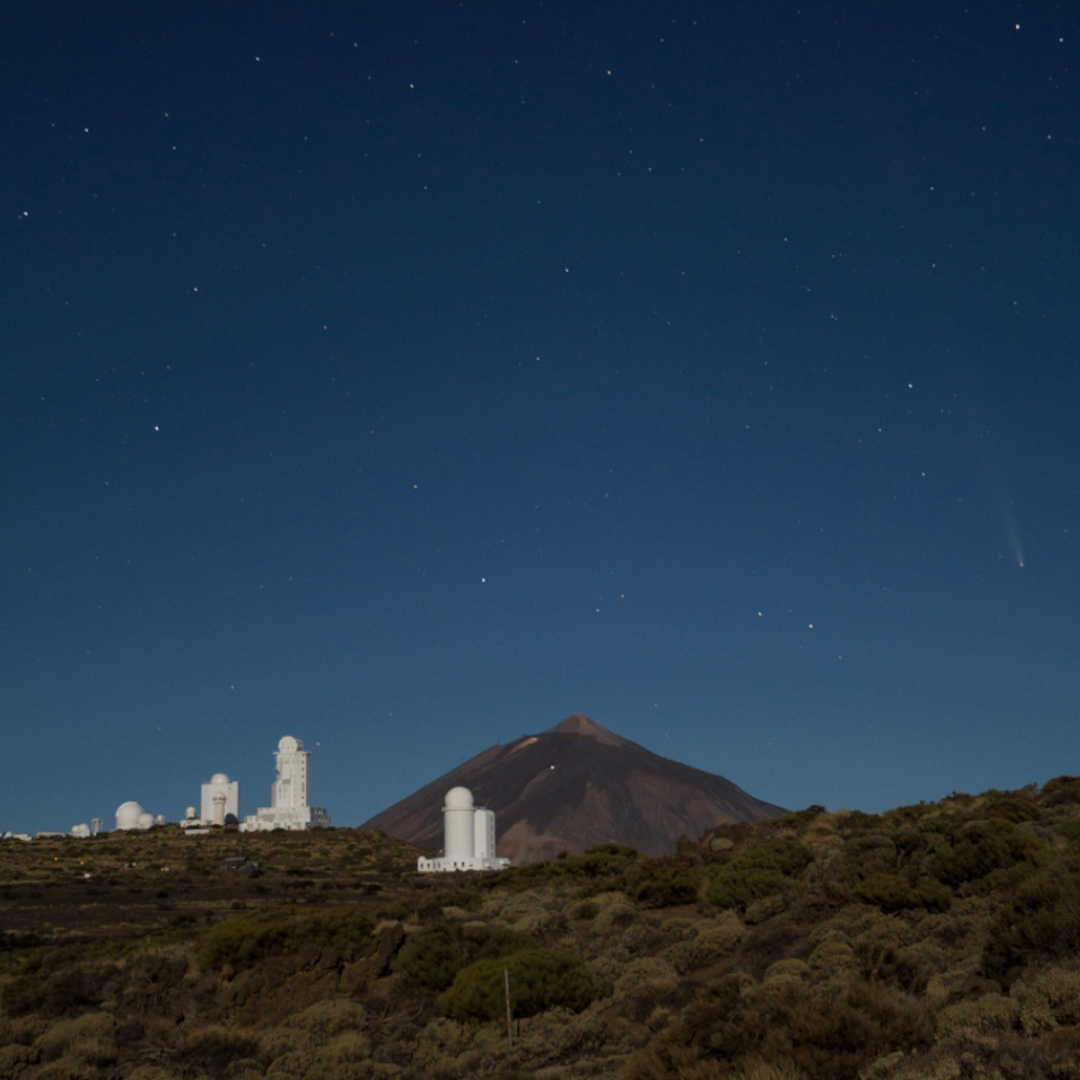
Teide Observatory, a beacon of science at the heart of the universe
Located at an altitude of almost 2,400 meters in the Teide National Park, the Teide Observatory is one of the most important astronomical research centers in the world. Far from being just a destination for stargazing, this observatory is a pillar of scientific discovery, from the study of the sun to the exploration of distant galaxies.
Introduction
Under the crystalline sky of the Teide Observatory in Tenerife, the history of astrophysics in the Canary Islands is written.
Since its foundation in 1964, when a telescope from the University of Bordeaux began to study the zodiacal light, the diffuse glow created by interplanetary dust, this enclave at an altitude of 2,390 meters has become a beacon of world science. The clarity of its sky and its strategic location have made it ideal for exploring from the Sun to the farthest reaches of the cosmos.
The Teide Observatory is the cradle of scientific milestones. In 1979, it gave birth to helioseismology, the science that studies the Sun’s vibrations to unravel its inner secrets. State-of-the-art solar telescopes, such as GREGOR, one of the most advanced in Europe, analyze our star in unprecedented detail.
But Teide does not stop during the day: its night telescopes have monitored historic comets, such as Shoemaker-Levy 9, mapped the center of our galaxy and discovered the first brown dwarf, christened Teide 1, an object somewhere between a star and a planet. In addition, pioneering experiments have detected microwave background anisotropies, echoes of the Big Bang that reveal the origins of the universe.

Credit: Luliia Dutchak
Today, the observatory combines tradition and modernity. Its robotic telescopes, such as those of the Two-meter Twin Telescope (TTT) project, explore exoplanets, black holes and potentially dangerous asteroids, while preparing to detect primordial gravitational waves, a window to the early universe.
The Observatory Residence, operational since 1990, supports the scientific staff, and the Instituto de Astrofísica de Canarias (IAC) brings the stars closer to the community with school visits to a dome converted into an outreach center.
The Teide Observatory not only illuminates the cosmos, but also inspires generations to look at the sky. It is a source of pride for the Canary Islands and a reminder that, from this island, the universe is a little closer.
A premier center for solar astronomy
The Teide Observatory, managed by the Instituto de Astrofísica de Canarias (IAC), is recognized as the largest solar observatory in the world.
Its telescopes, such as GREGOR or the Vacuum Tower Telescope (VTT), are designed to study the Sun in unprecedented detail.
Scientists here investigate phenomena such as:
- Sunspots: Regions of intense magnetic activity that affect space weather.
- Solar flares: Explosions that release energy equivalent to millions of nuclear bombs.
- Solar protuberance: Plasma arcs that reveal the secrets of the solar atmosphere.
Every day, the observatory produces at least one scientific publication, contributing to our understanding of how the Sun influences Earth and other planets. For example, its data help predict solar storms that can affect satellites, power grids and communications.
Why is Teide ideal for astronomy?
The Teide Observatory is not just anywhere, its location in the Teide National Park is a key factor for its success. The surrounding conditions create a perfect natural laboratory for astronomy, the main reasons are the following:
- Clear skies: With only 400 mm of annual rainfall and a clean atmosphere thanks to the trade winds, Teide offers more than 78% of useful time for observations, which means that most nights and days are clear.
- Low light pollution: Certified as a Starlight Destination, the altitude and remoteness from urban centers guarantee dark skies.
- Atmosphere: The island enjoys a stable atmosphere, especially at high altitudes, with low atmospheric turbulence, which reduces distortions, crucial for high-precision telescopes and experiments.
- Geographical location: Tenerife is located at a latitude that allows observing both the northern hemisphere sky and part of the southern hemisphere, offering a wide variety of celestial objects.
- Versatility: Teide is ideal for solar astronomy, night astronomy and cosmology. This diversity makes it a comprehensive center, capable of addressing everything from the Sun to the early universe.
- Conditions for outreach and education: The clarity of the sky and the infrastructure of Teide facilitate astronomical outreach. The IAC organizes visits, allowing students and the general public to connect with science.
These characteristics make Teide a place comparable to the observatories of Mauna Kea (Hawaii) or the Atacama Desert (Chile), but with the advantage of being in Europe.
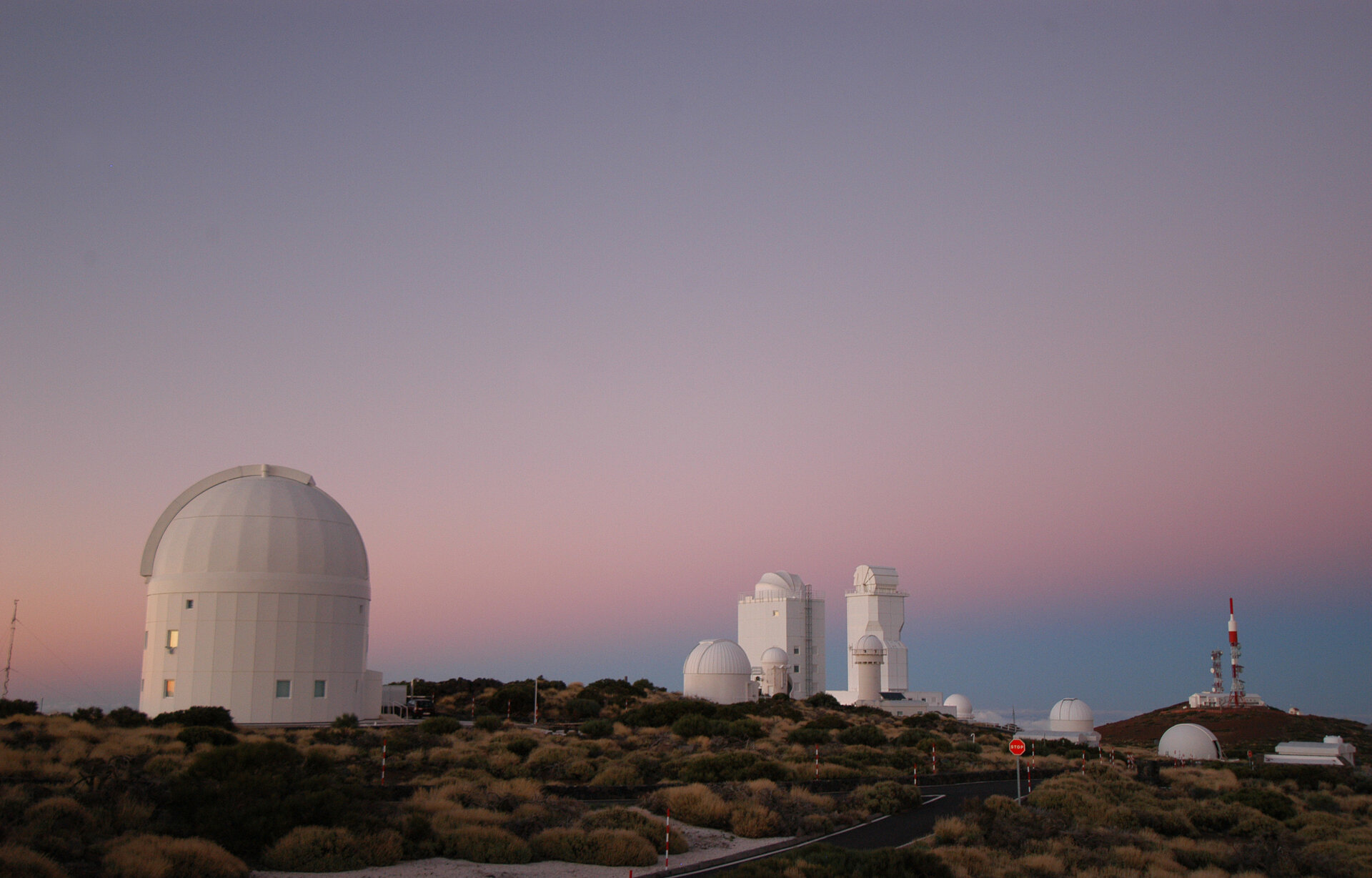
Image credit: IQOQI Viena, Austrian Academy of Sciences | @ESA
Sky quality of astronomical observatories in the Canary Islands
Since 1990, the Instituto de Astrofísica de Canarias (IAC) has been leading efforts to preserve this wonder through its sky quality team, created to study and protect the exceptional conditions of the skies over Tenerife and La Palma.
This team monitors key parameters, such as seeing, image sharpness, with a median of 0.7” in the Canary Islands, comparable to the best global observatories. It also designs instruments, investigates atmospheric optics and supports projects such as the Two-meter Twin Telescope (TTT) or the GREGOR solar telescope.
Its data have been vital for milestones such as the Tenerife Experiment, and for planning the future European Solar Telescope (EST).
Protecting the sky, a legal commitment
Since 1992, the IAC’s Technical Office for the Protection of the Quality of the Sky (OTPC) has been monitoring the Sky Law (1988), a pioneering regulation that protects Canarian observatories from four threats:
- Light pollution, regulating lighting in Tenerife and La Palma to maintain dark skies.
- Radio interference, limiting emissions that affect sensitive instruments.
- Atmospheric pollution, by controlling activities that generate dust or gases.
- Air routes, preventing aircraft from interfering with observations.
The OTPC advises on illumination projects, certifies equipment and collaborates with agencies such as AEMET to preserve the atmosphere. Its work ensures that telescopes capture clear images under the best possible conditions.
Teide Observatory facilities
The observatory covers an area of about 50 hectares and has a visitor center for scientific dissemination and a residence for scientific and technical personnel.
Solar telescopes
Gregor Solar Telescope

Gregor solar telescope. Image author: H. Raab (User: Vesta)
The GREGOR solar telescope was built by a German consortium consisting of the Institute for Solar Physics (KIS), the Leibniz Institute for Astrophysics Potsdam (AIP) and the Max-Planck Society represented by the Max Planck Institute for Solar System Research (MPS) in Göttingen.
The Institute for Astrophysics at the University of Göttingen was a member until 2008. The Instituto de Astrofísica de Canarias (IAC) and the Astronomical Institute of the Academy of Sciences of the Czech Republic contributed to the telescope and instruments.
With an aperture of 1.5 m, GREGOR has been in scientific operation since 2013. It is designed for high-precision measurements of the magnetic field and gas motion in the solar photosphere and chromosphere, resolving 70 km details on the solar surface.
It also performs high-resolution stellar spectroscopy. This capability is crucial for understanding the Sun’s magnetic activity, which is responsible for various phenomena and variations in its luminosity, since many important processes occur on very small spatial scales.
A large telescope like GREGOR is essential to observe these details and to obtain the precision needed to quantitatively understand the solar magnetic field. GREGOR is the largest European solar telescope in the visible and near IR spectral regime.
Learn more about in this link: Gregor
THEMIS solar telescope
At the beginning of the 21st century, the measurement and understanding of solar magnetic fields have become central topics following important advances in the study of the Sun’s internal structure. There is a growing interest in the generation, transport and behavior of magnetic fields, coronal heating, interplanetary magnetic field structure, space climatology and Sun-Earth relations.
The THEMIS telescope (‘Heliographic Telescope for the Study of Magnetism and Solar Instabilities’), is a joint French-Italian project. With an aperture of 90 cm, it is the third largest solar telescope in the world and is designed for high-precision, high-resolution spectropolarimetry in monochromatic imaging of the solar surface.
THEMIS features a Ritchey-Chretein design, altazimuth mount, helium-filled tube and a Stokes polarimeter. Its multi-mode spectrograph allows routine analysis in vector polarimetry with high precision and simultaneous observation of up to 10 wavelengths, enabling 3D inversions of the magnetic field structure in the solar atmosphere.
THEMIS offers three complementary observing modes: MTR (multi-line spectropolarimetry), MSDP (multi-channel spectro-imaging with polarimetry) and IPM (narrow-band imaging with filters and interferometer).
THEMIS observations have revealed parasitic polarities in the magnetic fields of filament channels and have identified depressions in the magnetic lines of force that could explain the accumulation of cold plasma in the filament “feet”.
In addition, THEMIS has allowed direct measurements of magnetic fields in protrusions, obtaining stronger than expected values by circular polarization of helium spectral lines.
Learn more about in this link: THEMIS
Themis telescope. Image credit: Benjamín Núñez González
Vacuum Tower Solar Telescope (VTT)
The Vacuum Tower Telescope (VTT) was installed in 1986 and has been operational since 1988, belonging to four German institutions: the Astrophysical Institute in Potsdam, the Kiepenheuer Institute for Solar Physics (Freiburg, lead institution), the Max Plank Institute for Solar System Research (Lindau) and the Observatory of the University of Göttingen.
It is a classical solar telescope with a celostat system of two 80 cm mirrors directing sunlight to a fixed telescope.
The main telescope has a spherical mirror of approximately 46 m focal length inside a 30 m vertical vacuum tank with inlet and outlet windows. The reflected light is directed downward and then outward to a laboratory, where a constant orientation of the solar image is maintained by the celostat system.
The tank is evacuated to minimize internal air turbulence, and adaptive optics are used to correct for image distortions caused by the Earth’s atmosphere.
It conducts 30-40 observing campaigns per year between April and December. Its instrumentation allows the study of plasma flows and magnetic fields on the Sun, with simultaneous observations in different spectra and resolution of objects up to 150 km on the solar surface, using adaptive optics.
Key data:
Primary mirror diameter: 70 cm
Focal length: 45,940 m
Focal ratio (f/D): 65.7
Resolution at 543.4 nm: 0.196 arcseconds
Image scale at primary focus: 4.59 arcseconds per millimeter
Learn more about in this link: VTT
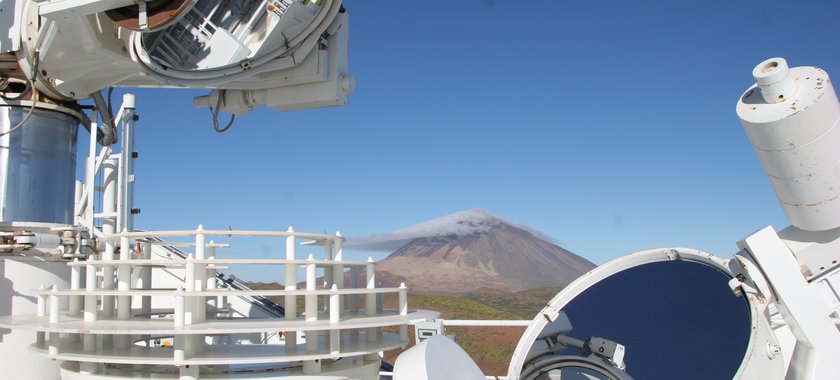
VTT telescope | Image credit: J. Rendtel/AIP
Night telescopes
IAC-80

Photograph by Mike Peel (www.mikepeel.net)
The IAC80 telescope, designed and built by the IAC, was the first of its kind in Spain and was installed at the Teide Observatory in 1991.
With an 82 cm primary mirror and configured for optical observations, it is ideal for long-term programs, collaborations, urgent observations, student practices and instrumentation tests.
Equipped with the CAMELOT2 camera, the IAC80 also serves as a test bench for instrumentation of larger telescopes (such as the GTC), for atmospheric characterization of the Canary observatories, and for training university students.
Its versatility and availability make it a key part of the Teide Observatory. The IAC80 has contributed significantly to astronomy with more than 100 publications.
Its varied observations range from comets (such as Shoemaker-Levy 9) to quasars and gravitational lenses. Highlights include the discovery of Teide 1 (the first brown dwarf), the study of a gravitational lens that provided data on dark matter, and the imaging of the source of a powerful gamma-ray burst.
Carlos Sanchez Telescope (TCS)
The Carlos Sanchez Telescope (TCS), with a 1.52 meter mirror, is configured primarily for nighttime infrared observations. Designed by J. Ring and built in collaboration between the UK and the IAC, it was commissioned in 1972 after being installed in Tenerife in 1971.
Initially conceived as a low-cost flux collector, it was one of the first thin-mirror telescopes. In 1983, SERC transferred ownership to the IAC, which made improvements in maintenance, automation and instrumentation.
The telescope was named in honor of Dr. Carlos Sánchez Magro, professor of astrophysics at the University of La Laguna and a key figure at the IAC, especially in the promotion of infrared astronomy.
The TCS is ideal for observing “cold” objects such as early or late evolving stars, and obtained early infrared images of the impact of comet Shoemaker-Levy 9 on Jupiter and of substellar objects. It often collaborates with other telescopes of the Teide Observatory (OGS and IAC80) for complementary observations.
Has produced nearly 250 scientific articles, with projects ranging from mapping the galactic center to the study of stellar oscillations.
Highlights include the creation of the first catalog of galaxies with star formation in the H band, the photometry of asteroid 2002 NY40, and the photometric study of Orion clusters that identified low-mass stars and possible brown dwarfs.

Carlos Sánchez Telescope. Image credit: Mike Peel (www.mikepeel.net)
MONS Reflector Telescope
The MONS telescope is a 50-cm reflector built by the University of Mons (Belgium) in 1972 for nighttime observation. Initially used for practical work by the Department of Astrophysics at the University of La Laguna, its primary use remains teaching, and it is requested by various universities and amateur groups for practical work.
OGS Telescope
The Optical Ground Station (OGS) was built by ESA to research optical communications with satellites and has been operated by the IAC since its inauguration in 1995.
The OGS is equipped with a 1 m telescope that allows three configurations:
- Ritchey-Chrétien: 13.3 m focal length, small field.
- Coudé: 38.95 m focal length.
- Ritchey-Chrétien: 4.5 m narrow focal length, wide field (~1 deg2).
It initially tested laser terminals on low- and geostationary orbit satellites. Since 2001, it has also tracked space debris. A third of its time is dedicated to astronomical research.
The OGS has achieved milestones such as establishing stable two-way links with the ARTEMIS satellite since 2001, analyzing the effects of atmospheric turbulence. Since 2002, it has used a Sodium Reference Star to improve adaptive optics. It has conducted tests with the Japanese OICETS satellite (launched in 2005) and carried out link campaigns with the SMART-1 spacecraft to characterize deep-space turbulence.
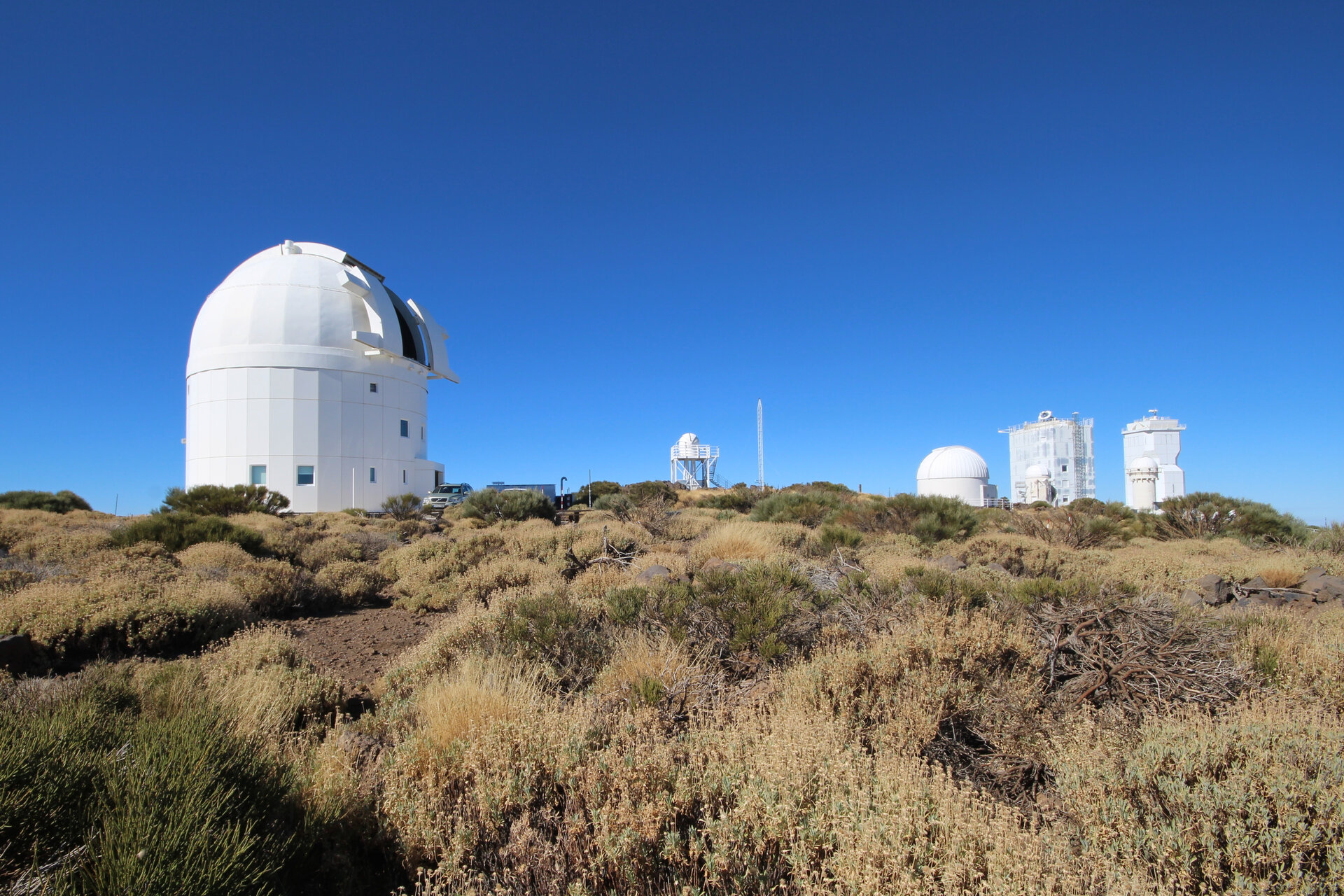
The OGS, on the left of the image, at the Teide Observatory. Image credit: Victor R. Ruiz
STELLA
STELLA (Stella Robotic Observatory) is a long-term project launched in 2006 with two 1.2 m robotic telescopes dedicated to observing activity in cool stars, using a high-resolution spectrograph (SES) and a wide-field imager (WiFSIP).
It is notable for its operational efficiency, with a technical downtime of only 2% and high shutter release times (87.5% for SES and 67.9% for WiFSIP). This is achieved by parallel execution of tasks, such as rotating and acquiring the next target while reading the previous exposure.
The STELLA Control System (SCS), a general-purpose software for optical telescopes, uses an XML-based meta-language to design new observing strategies. Scheduling is based on a dispatch scheme that optimizes the selection of observations from a large group using a greedy heuristic.
Both STELLA-I and STELLA-II telescopes were manufactured by Halfmann Teleskoptechnik and feature Alt/Az mounts. STELLA-I has an f/8 system with two Nasmyth foci and a 30-foot field of view. The telescopes use hydrostatic and ball bearings and are driven by ETEL direct drives with Heidenhain encoders, achieving high pointing and tracking accuracy.
Learn more at this link: STELLA
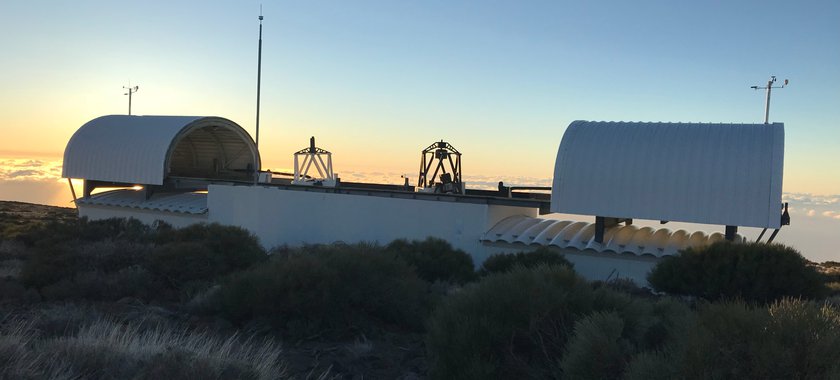
The two 1.2-meter robotic telescopes. Credit: AIP/STELLA
SONG
SONG (Stellar Observations Network Group) is a Danish project, initiated in 2006 by the Universities of Aarhus and Copenhagen, to build a global network of small, robotic telescopes to study stars and planetary systems.
The goal was to create a modern, affordable telescope with significant scientific impact. The 1.0-m Cassegrain telescope, manufactured by ASTELCO Systems GmbH on an alt-az mount, has a high rotation speed (20°/s) and pointing accuracy (<3” RMS). Its thin primary mirror is actively controlled.
With two Nasmyth foci, the telescope is remotely controlled and was installed at a relatively low cost (30 million Danish kroner). SONG’s uniqueness lies in its instrumentation and the planned global network of eight telescopes.
SONG’s scientific objectives are:
- To study the internal structure and evolution of stars using asteroseismology.
- To search for and characterize planets with masses comparable to Earth orbiting other stars.
Two-meter Twin Telescope (TTT)
It is a revolutionary astronomical project that combines cutting-edge robotic technology with an ambitious scientific approach. Operated by Light Bridges in collaboration with the Instituto de Astrofísica de Canarias (IAC), it is comprised of four telescopes: two 80-cm telescopes (TTT1 and TTT2, fully operational since December 2022) and two 2-meter telescopes (TTT3, which achieved first light in February 2025, and TTT4, under construction).
This complex represents a milestone in modern astronomy, both for its technological innovation and its public-private funding model.
The TTT is designed to address some of the greatest enigmas of the universe with unprecedented efficiency. Its robotic telescopes operate autonomously, using the Queue Planning Intelligent System (QPIS), a software based on machine learning algorithms that optimizes the selection of observations in real time.
This system allows scientific proposals to be evaluated in just 48 hours and delivers astrometrically and photometrically calibrated images within 24 hours, making it an ideal tool for research requiring rapid responses, such as the detection of supernovae or transient events.
This project is important because it covers a broad spectrum of research:
- Transient Events: Detect fleeting phenomena such as supernovae and gamma-ray bursts (GRBs), as well as electromagnetic counterparts of gravitational waves, essential for understanding the most energetic events in the universe.
- Exoplanets: Characterize new worlds and their systems, contributing to the search for habitable planets and the study of planetary formation.
- Black Holes: Conduct surveys to detect and analyze black holes, unraveling their role in cosmic evolution.
- Trans-Neptunian Objects (TNOs): Study the morphology of these distant bodies through stellar occultations, offering clues to the origins of the Solar System.
- Minor Bodies: Detect and characterize comets and asteroids, with a special focus on NEOs (near-Earth asteroids), including the dangerous “city killers.” The TTT also analyzes the physical properties (size, shape, composition, rotation) and dynamics of asteroids to assess their potential impact on Earth
- Solar Stars: Investigate variability and activity cycles in Sun-like stars, key to understanding stellar evolution.
- Low-luminosity Structures: Take advantage of the TTT’s wide field of view to study stellar halos, ultra-diffuse galaxies, and intracluster light, revealing subtle structures in the Universe.
- Space Debris: Detect and track satellites and orbital debris, a critical area for space safety.
Teide Observatory Solar Laboratory
The Teide Observatory Solar Laboratory (IAC) has been operating continuously with six instruments dedicated to a unique scientific program for over 25 years, both day and night. Although the instruments belong to various institutions, the IAC’s “Solar and Stellar Seismology and Exoplanet Search” group operates them and participates in their scientific exploitation through international consortia.
The main objective is the study of the solar interior through helioseismology, recently expanded to include asteroseismology, exoplanet detection, and measurement of the Earth’s albedo.
The IAC’s helioseismology group pioneered the discovery of the global nature of 5-minute solar oscillations in 1979. The first instrument was installed in 1976, providing unique data on the sensitivity of solar pulsations to the solar activity cycle.
In 1981, the feasibility of the “Observational Network” was demonstrated by combining data from similar instruments at different locations, significantly improving data quality. Since 1983, the Solar Laboratory has continuously contributed to globally used helioseismological databases.
Research lines include the development of instruments to study the solar background spectrum and detect gravitational modes, improving helioseismological data to study the solar tachocline, making precise measurements of acoustic mode frequencies to infer the Sun’s internal structure and rotation, detecting subsurface matter flows through local seismology, studying the thermodynamics of the photosphere, and analyzing correlations between helioseismological parameters and solar activity to understand the solar dynamo.

Solar pyramid. Image credit: Benjamín Núñez González – Own work, CC BY-SA 4.0, https://commons.wikimedia.org/w/index.php?curid=42160033
From that first telescope in 1964 to the advanced robotic telescopes of the Two-meter Twin Telescope (TTT), the Teide Observatory has been much more than a place of science: it is a bridge between the Canary Islands and the cosmos. Here, the cosmic microwave background told us about the Big Bang, we discovered the brown dwarf Teide 1, and we tracked comets that marked history.
Today, Teide continues to look to the future. Through school visits and outreach, the Instituto de Astrofísica de Canarias (IAC) brings the universe closer to everyone.
Visit Teide, marvel at its sky, and join this adventure that, from Tenerife, illuminates the secrets of infinity.
If you want to learn more about the observatory, its studies, news, or simply to expand your knowledge, you can visit the official IAC website as well as the IAC Canary Islands Observatories website.

 Español
Español

